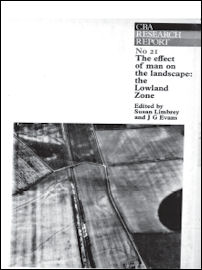CBA Research Reports
Council for British Archaeology, 2000. (updated 2020) https://doi.org/10.5284/1000332. How to cite using this DOI
Data copyright © Council for British Archaeology unless otherwise stated
This work is licensed under the ADS Terms of Use and Access.
Primary contact
Council for British Archaeology
92 Micklegate
York
YO1 6JX
UK
Tel: 01904 671417
Resource identifiers
- ADS Collection: 281
- DOI:https://doi.org/10.5284/1000332
- How to cite using this DOI
The effect of man on the landscape: the Lowland Zone
Susan Limbrey and J G Evans
CBA Research Report No 21 (1978)
ISBN 0 900312 60 2
Abstract

Nineteen papers from an interdisciplinary conference held at Reading in December 1975 study the physical basis of the Lowland Zone landscape, its flora and fauna, and the effects of human occupation upon it. The introductory paper by P J Fowler (pp 1-12) considers some of 'Fox's Laws' in the light of newer research, and argues that after the later 2nd millennium BC, because of landscape exploitation and environmental change, it is the Lowland Zone rather than the Highland which demonstrates cultural unity and continuity. Population sizes are also discussed.
Three papers on soils come from: J A Catt (12-20) on the widespread (though patchy) distribution of loess in Britain; Susan Limbrey (21-7) on the changes in quality and distribution of lowland soils due to forest disturbance and increasingly intensive agriculture; and F W Shotton (27-32) on three alluvium sections in the lower Severn-Avon valleys which attest large scale ploughing from about 650 BC onwards.
The study of insects (P J Osborne, 32-4) has given clues to changes from forest to grassland cover M A Robinson (35-43) has used all kinds of biological remains to deduce the contemporary environment of Iron Age and Roman sites on the first gravel terrace of the Thames in Oxfordshire. P C Buckland (43-5) points out that a large increase in the depredations of the grain weevil (Sitophilus granarius L) would arise from the cessation of underground cereal storage after the Roman conquest, perhaps accounting for the considerable extension of arable cultivation during the Roman period. From the literature on Late Glacial and Early Flandrian ungulates Caroline Grigson (46-56) tries to establish which of the larger species were present in each of Zones I-VIIA.
New data on the vegetational history of Norfolk are summarized by R E Sims (57-62), whose modern techniques of pollen analysis on Hockham Mere and Seamere revealed possible evidence of Mesolithic forest clearance.
Molluscan evidence for habitat change in two tufa sites in S Britain is presented by J G Evans, C French & D Leighton (63-75). R M Jacobi (75-85) shows that the density of Meso settlement in Lowland Britain was greater than hitherto supposed; while certain geological conditions were preferred, resources of many different soils were exploited and there is evidence for (eg) manipulation of hazelnut cropping. The Somerset Levels landscape, rich in water wood and pasture, and all the resources they imply, is the subject of J M Coles (86-9) while F A Hibbert (90-5) gives fuller details of their vegetational history by means of an absolute pollen diagram.
Late Neo-BA colonization and land use are considered by R Bradley (95-103) who argues that economic changes began, even before the Beaker arrivals, to encourage expansion of settlement on to secondary soils; this was emphasized and developed during EBA. Ard shares, because of their good survival and information content, are analysed by Sian Rees (103-14) and explained as best fitted to a bow ard; she also considers experimental ard-ploughing and soilmark evidence. H C Bowen (115-23) considers the evidence for 'ranch' boundaries (linear ditches) in Wessex where, with the partial exception of Dorset, they can override 'Celtic' fields and suggest potent authority at work. Many relate to roads and modern parish boundaries; their original appearance (?fences, hedges?) is discussed.
Place-name evidence for man's effect on the Berkshire landscape is Margaret Gelling's subject (123-5). Field evidence for village mobility in Saxon, medieval and later times is discussed by C C Taylor (126-34) with particular reference to Northamptonshire Dr Willy Groenman-van Waateringe's closing paper (135-46) finds for the Neolithic Netherlands a quantity of evidence for people adapting to the landscape they inhabited; she also discusses hedges and other boundary markers.
Contents
- Title pages
- Editors' Foreword (p v)
- List of Contributors (p v)
- Lowland landscapes: culture, time, and Personality by P J Fowler (p 1)
- The contribution of loess to soils in lowland Britain by J A Catt (p 12)
- Changes in quality and distribution of the soils of lowland Britain by Susan Limbrey (p 21)
- Archaeological inferences from the study of alluvium in the lower Severn-Avon valleys by F W Shotton (p 27)
- Insect evidence for the effect of man on the lowland landscape by P J Osborne (p 32)
- A comparison between the effects of man on the environment of the first gravel terrace and flood-plain of the Upper Thames Valley during the Iron Age and Roman periods by M A Robinson (p 35)
- Cereal production, storage, and population: a caveat by P C Buckland (p 43)
- The Late Glacial and Early Flandrian ungulates of England and Wales - an interim review by Caroline Grigson (p 46)
- Man and vegetation in Norfolk by R E Sims (p 57)
- Habitat change in two Late-glacial and Post-glacial sites in southern Britain: the molluscan evidence by J G Evans, C French and D Leighton (p 63)
- Population and landscape in Mesolithic lowland Britain by R M Jacobi (p 75)
- Man and landscape in the Somerset Levels by J M Coles (p 86)
- The vegetational history of the Somerset Levels by F A Hibbert (p 90)
- Colonization and land use in the Late Neolithic and Early Bronze Age by R Bradley (p 95)
- Tools available for cultivation in prehistoric Britain by Sian Rees (p 103)
- 'Celtic' fields and 'ranch' boundaries in Wessex by H C Bowen (p 115)
- The effect of man on the landscape: the place-name evidence in Berkshire by Margaret Gelling (p 123)
- Aspects of village mobility in medieval and later times by C C Taylor (p 126)
- The impact of Neolithic man on the landscape in the Netherlands by Willy Groenman-van Waateringe (p 135)
- Index (p 147)
Download report
| The effect of man on the landscape: the Lowland Zone (CBA Research Report 21) | 6 Mb |







